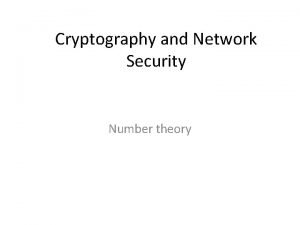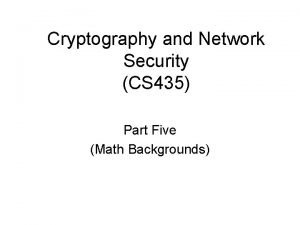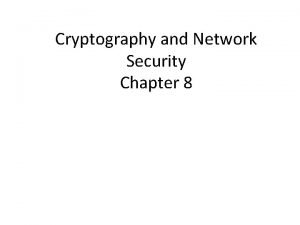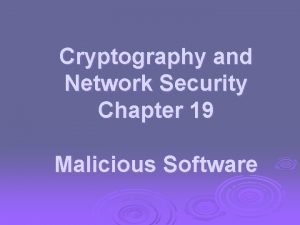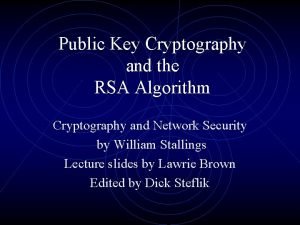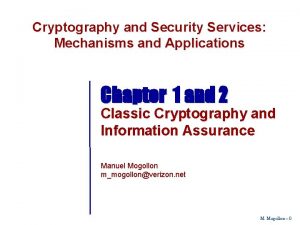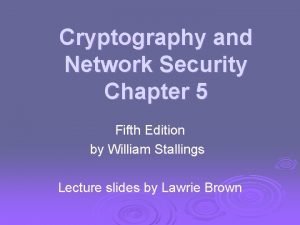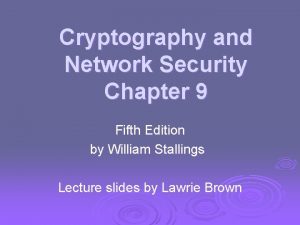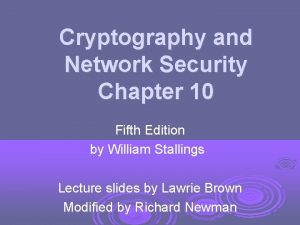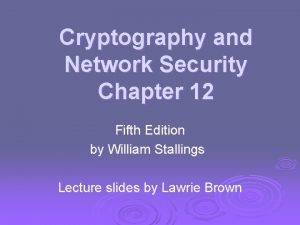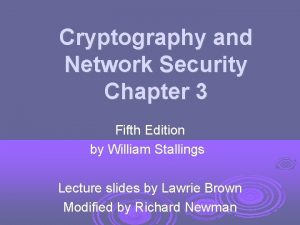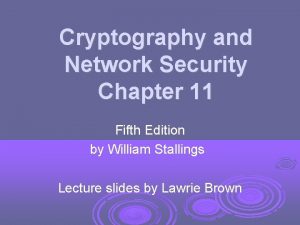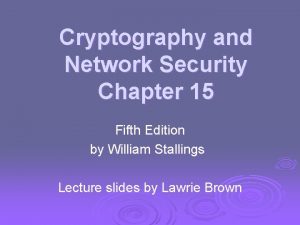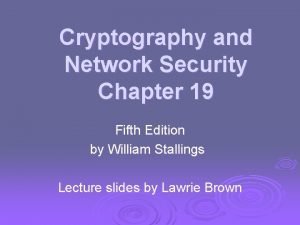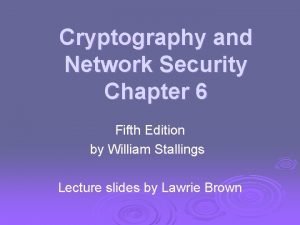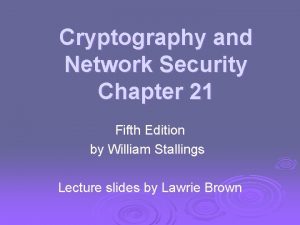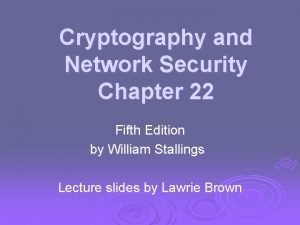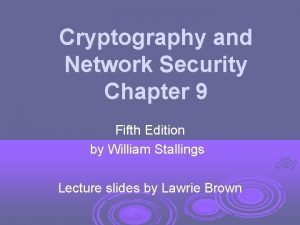Cryptography and Network Security Chapter 18 Fifth Edition

































- Slides: 33

Cryptography and Network Security Chapter 18 Fifth Edition by William Stallings Lecture slides by Lawrie Brown

Chapter 15 – Electronic Mail Security Despite the refusal of VADM Poindexter and Lt. Col North to appear, the Board's access to other sources of information filled much of this gap. The FBI provided documents taken from the files of the National Security Advisor and relevant NSC staff members, including messages from the PROF system between VADM Poindexter and Lt. Col North. The PROF messages were conversations by computer, written at the time events occurred and presumed by the writers to be protected from disclosure. In this sense, they provide a first-hand, contemporaneous account of events. —The Tower Commission Report to President Reagan on the Iran-Contra Affair, 1987

Email Security Ø email is one of the most widely used and regarded network services Ø currently message contents are not secure l l may be inspected either in transit or by suitably privileged users on destination system

Email Security Enhancements Ø confidentiality l protection from disclosure Ø authentication l of sender of message Ø message integrity l protection from modification Ø non-repudiation of origin l protection from denial by sender

Pretty Good Privacy (PGP) Ø widely used de facto secure email Ø developed by Phil Zimmermann Ø selected best available crypto algs to use Ø integrated into a single program Ø on Unix, PC, Macintosh and other systems Ø originally free, now also have commercial versions available

PGP Operation – Authentication 1. 2. 3. 4. 5. sender creates message make SHA-1160 -bit hash of message attached RSA signed hash to message receiver decrypts & recovers hash code receiver verifies received message hash

PGP Operation – Confidentiality 1. 2. 3. 4. 5. sender forms 128 -bit random session key encrypts message with session key attaches session key encrypted with RSA receiver decrypts & recovers session key is used to decrypt message

PGP Operation – Confidentiality & Authentication Ø can use both services on same message l l l create signature & attach to message encrypt both message & signature attach RSA/El. Gamal encrypted session key

PGP Operation – Compression Ø by default PGP compresses message after signing but before encrypting l l so can store uncompressed message & signature for later verification & because compression is non deterministic Ø uses ZIP compression algorithm

PGP Operation – Email Compatibility when using PGP will have binary data to send (encrypted message etc) Ø however email was designed only for text Ø hence PGP must encode raw binary data into printable ASCII characters Ø uses radix-64 algorithm Ø l l Ø maps 3 bytes to 4 printable chars also appends a CRC PGP also segments messages if too big

PGP Operation – Summary

PGP Session Keys Ø need a session key for each message l of varying sizes: 56 -bit DES, 128 -bit CAST or IDEA, 168 -bit Triple-DES Ø generated using ANSI X 12. 17 mode Ø uses random inputs taken from previous uses and from keystroke timing of user

PGP Public & Private Keys Ø since many public/private keys may be in use, need to identify which is actually used to encrypt session key in a message l l Ø rather use a key identifier based on key l l Ø could send full public-key with every message but this is inefficient is least significant 64 -bits of the key will very likely be unique also use key ID in signatures

PGP Message Format

PGP Key Rings Ø each PGP user has a pair of l l keyrings: public-key ring contains all the public-keys of other PGP users known to this user, indexed by key ID private-key ring contains the public/private key pair(s) for this user, indexed by key ID & encrypted keyed from a hashed passphrase Ø security of private keys thus depends on the pass-phrase security

PGP Key Rings

PGP Message Generation

PGP Message Reception

PGP Key Management rather than relying on certificate authorities Ø in PGP every user is own CA Ø l Ø can sign keys for users they know directly forms a “web of trust” l l trust keys have signed can trust keys others have signed if have a chain of signatures to them key ring includes trust indicators Ø users can also revoke their keys Ø

PGP Trust Model Example

S/MIME (Secure/Multipurpose Internet Mail Extensions) Ø security enhancement to MIME email l l original Internet RFC 822 email was text only MIME provided support for varying content types and multi-part messages with encoding of binary data to textual form S/MIME added security enhancements Ø have S/MIME support in many mail agents l eg MS Outlook, Mozilla, Mac Mail etc

S/MIME Functions Ø enveloped data l encrypted content and associated keys Ø signed data l encoded message + signed digest Ø clear-signed data l cleartext message + encoded signed digest Ø signed & enveloped data l nesting of signed & encrypted entities

S/MIME Cryptographic Algorithms Ø digital signatures: DSS & RSA Ø hash functions: SHA-1 & MD 5 Ø session key encryption: El. Gamal & RSA Ø message encryption: AES, Triple-DES, RC 2/40 and others Ø MAC: HMAC with SHA-1 Ø have process to decide which algs to use

S/MIME Messages Ø S/MIME secures a MIME entity with a signature, encryption, or both Ø forming a MIME wrapped PKCS object Ø have a range of content-types: l l l enveloped data signed data clear-signed data registration request certificate only message

S/MIME Certificate Processing Ø S/MIME uses X. 509 v 3 certificates Ø managed using a hybrid of a strict X. 509 CA hierarchy & PGP’s web of trust Ø each client has a list of trusted CA’s certs Ø and own public/private key pairs & certs Ø certificates must be signed by trusted CA’s

Certificate Authorities Ø have several well-known CA’s Ø Verisign one of most widely used Ø Verisign issues several types of Digital IDs Ø increasing levels of checks & hence trust Class 1 2 3 Identity Checks name/email check + enroll/addr check + ID documents Usage web browsing/email, subs, s/w validate e-banking/service access

S/MIME Enhanced Security Services Ø 3 proposed enhanced security services: l l l signed receipts security labels secure mailing lists

Domain Keys Identified Mail Ø a specification for cryptographically signing email messages Ø so signing domain claims responsibility Ø recipients / agents can verify signature Ø proposed Internet Standard RFC 4871 Ø has been widely adopted

Internet Mail Architecture

Email Threats Ø see RFC 4684 - Analysis of Threats Motivating Domain. Keys Identified Mail Ø describes the problem space in terms of: l l l range: low end, spammers, fraudsters capabilities in terms of where submitted, signed, volume, routing naming etc outside located attackers

DKIM Strategy Ø transparent to user l l MSA sign MDA verify Ø for pragmatic reasons

DCIM Functional Flow

Summary Ø have considered: l l secure email PGP S/MIME domain-keys identified email
 Modulo table
Modulo table Cryptography and network security 6th edition pdf
Cryptography and network security 6th edition pdf Cryptography and network security 4th edition
Cryptography and network security 4th edition Cryptography and network security 7th edition
Cryptography and network security 7th edition Wireless security in cryptography
Wireless security in cryptography Introduction to cryptography and network security
Introduction to cryptography and network security Number theory in network security
Number theory in network security Firewall base layer
Firewall base layer Authentication in cryptography and network security
Authentication in cryptography and network security Intruders in cryptography and network security
Intruders in cryptography and network security What is primitive root in cryptography
What is primitive root in cryptography Source
Source Euler's theorem in cryptography and network security
Euler's theorem in cryptography and network security Finite fields in cryptography and network security
Finite fields in cryptography and network security Digital signature in cryptography and network security
Digital signature in cryptography and network security Modular arithmetic in cryptography and network security
Modular arithmetic in cryptography and network security Pgp in cryptography and network security
Pgp in cryptography and network security Euler's theorem in cryptography and network security
Euler's theorem in cryptography and network security Malicious software in cryptography and network security
Malicious software in cryptography and network security Introduction to cryptography and network security
Introduction to cryptography and network security Rsa algorithm in cryptography and network security
Rsa algorithm in cryptography and network security Introduction to cryptography and network security
Introduction to cryptography and network security Principles of marketing fifth european edition
Principles of marketing fifth european edition Lazarus appraisal theory
Lazarus appraisal theory Fundamentals of corporate finance fifth edition
Fundamentals of corporate finance fifth edition Fifth edition chemistry a molecular approach
Fifth edition chemistry a molecular approach Molecular biology
Molecular biology Molecular biology of the cell fifth edition
Molecular biology of the cell fifth edition Human anatomy fifth edition
Human anatomy fifth edition Human anatomy fifth edition
Human anatomy fifth edition Network security essentials 5th edition pdf
Network security essentials 5th edition pdf Cryptographic systems are generically classified by
Cryptographic systems are generically classified by Privat security
Privat security Security services of cryptography
Security services of cryptography












